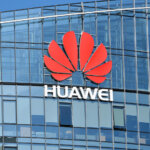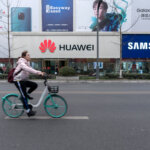Did Huawei defy US Sanctions with its Mate 60 Pro?
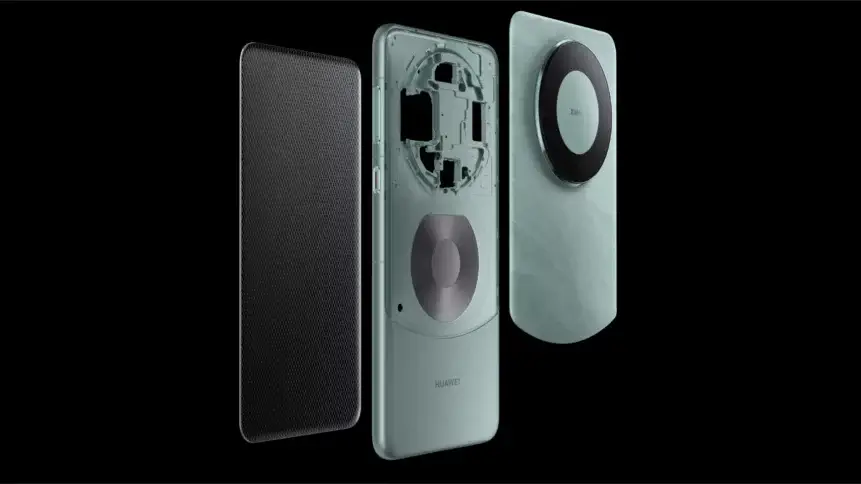
- Huawei claims its Mate 60 Pro is the “most powerful Mate model ever.”
- But cunningly, the company never mentions its CPU or the handset’s 5G connectivity.
- Users are identifying the Mate 60 Pro’s CPU as the HiSilicon-designed Kirin 9000s, which supports 5G and AI.
Not too long after the US began imposing sanctions against Huawei Technologies Co, the Chinese telecommunications giant proved that it is still, to an extent, capable of surviving without American-made materials. To demonstrate how it has been “business as usual” for Huawei despite the mounting US sanctions, the company quietly released its latest smartphone last week — the Mate 60 Pro — which is proving to have network speed similar to a 5G smartphone.
In fact, Huawei may have just released its first 5G smartphone since the US sanctions cut the Chinese tech giant off from critical chip supplies and production partners. However, Huawei unveiled the Mate 60 Pro without sharing much on specs — indicating that it may be subtly getting back into the race.
Reviews have been pouring in since the unveiling of the Mate 60 Pro on August 29, and they all say the same thing: Huawei is using advanced in-house chips, giving the phone 5G specifications. At first look, the Mate 60 Pro looks like any other Chinese phone, with advancements that set it apart from its predecessor.
However, unlike Huawei’s usual launches, the smartphone release was not accompanied by a big teaser campaign or a significant event. Huawei has also declined opportunities to provide details about the handset’s processor or whether it supports 5G mobile networks.
Industry analysts and consumers didn’t take long to specualate on the embattled Chinese giant’s unusual behavior. The launch was, intentionally or otherwise, timed during US Commerce Secretary Gina Raimondo’s visit to China last week. Raimondo’s visit was the fourth high-level US official to visit China this summer, amid an increasingly intense bilateral relationship between the nations.
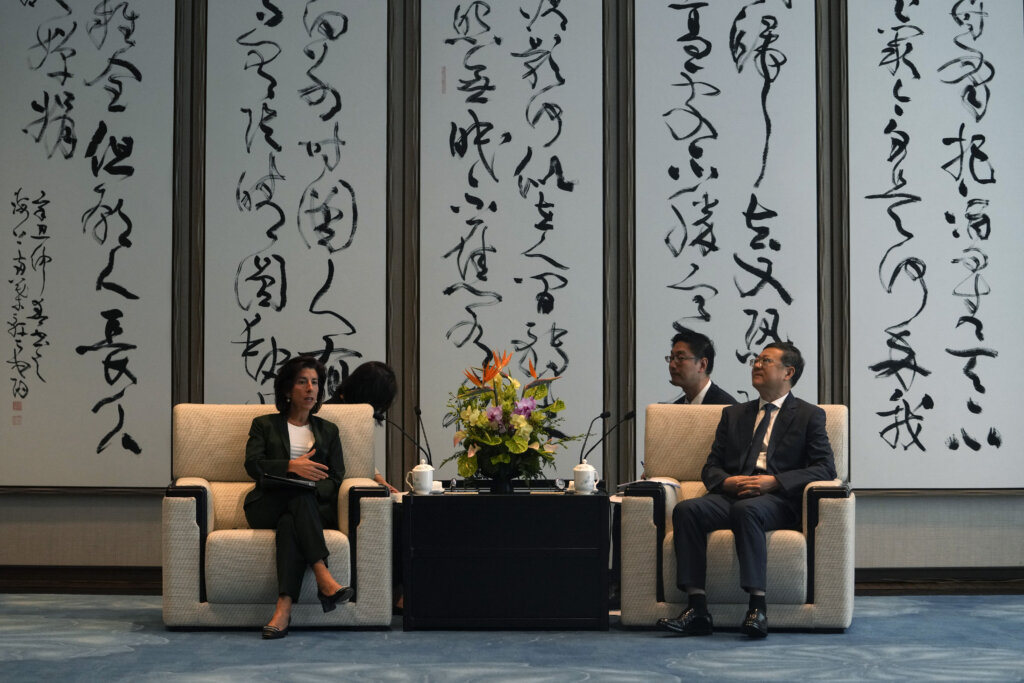
US Commerce Secretary Gina Raimondo (L) talks with Shanghai Party Secretary Chen Jining during a meeting in Shanghai on August 30, 2023. (Photo by Andy Wong / POOL / AFP)
Chinese state media declared the timing of the phone announcement was a show of defiance, indicating to the US that the trade war was a “failure.” Not too long after growing speculation in China on this point, there were hushed concerns in Washington, too. Countless reports suggested that the US sanctions had clearly failed to prevent China from making a critical technological advance.
For now, it seems US chipmakers were right when they warned that far-reaching sanctions would not stop China, but in fact spur it to redouble its efforts to build alternatives to US technology.
Details on the Huawei Mate 60 Pro
Details regarding the device’s processor and network support were notably absent from the published spec sheet, leaving consumers and industry watchers curious about the device’s true capabilities. Yet, many local reviewers claimed that the phone reached 5G speeds. The only giveaway from Huawei, based on its statement on August 29, is that the Mate 60 Pro was the “most powerful Mate model ever,” without mentioning its CPU or the handset’s 5G connectivity.
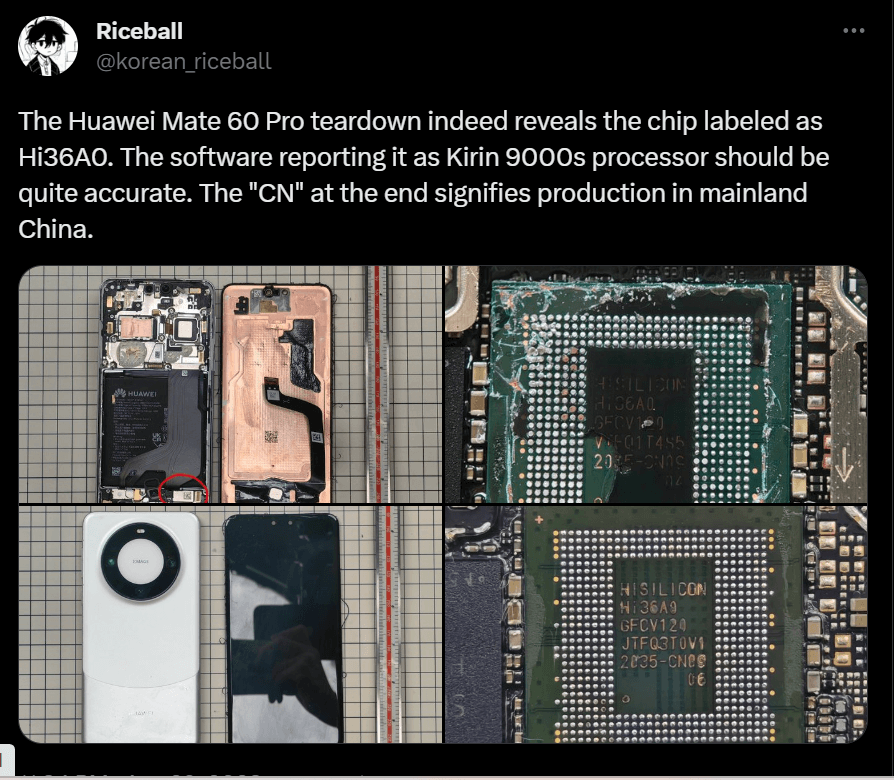
Inside the Huawei Mate 60 Pro. Source: Twitter
Based on tests, the Chinese benchmarking website AnTuTu identified the central processing unit (CPU) in the Mate 60 Pro as the Kirin 9000s from Huawei’s chip design unit, HiSilicon. The CPU has a 12-core configuration and a top clock speed of 2.62 gigahertz, according to AnTuTu. For context, Shenzhen-based Huawei and chip design arm HiSilicon were added to the US government’s trade blacklist, known as the Entity List, in 2019.
Tightened US restrictions imposed in 2020 restrict Huawei from obtaining advanced integrated circuits (ICs) from major contract chipmakers, such as Taiwan Semiconductor Manufacturing Co. or Samsung Electronics. Although HiSilicon’s website did not provide information about that CPU, the firm’s existing Kirin 9000 and 9000e chipsets support 5G connectivity and artificial intelligence applications. They are built on the advanced 5nm manufacturing process.
The Mate 40 series, released in October 2020, was the last 5G smartphone launched by Huawei, which used the HiSilicon-designed Kirin 9000 system-on-a-chip in the device. “The new Mate’s download speeds can reach 500 megabits per second, which exceeds the 100Mbps speed requirements for 4G networks, according to independent tests run by some consumers,” the South China Morning Post (SCMP) wrote.
China’s official broadcaster, CGTN, in a post on X, called the phone Huawei’s “first higher-end processor” since US sanctions were imposed and said the chip it contains was made by Semiconductor Manufacturing International Corp, a company partially owned by the Chinese government. Separately, Nikkei Asia reported that SMIC would be using what’s known as the “7nm process” to make the chips for Huawei, the most advanced level in China.
In simple terms, the process is on par with that used for the chips inside Apple’s iPhones launched in 2018. The Taiwan Semiconductor Manufacturing Company made the latest iPhone chips using what is known as the 4nm process. As for the graphics processing unit in the new Mate, AnTuTu identified it as another Chinese-designed chip, the Maleoon 910.






